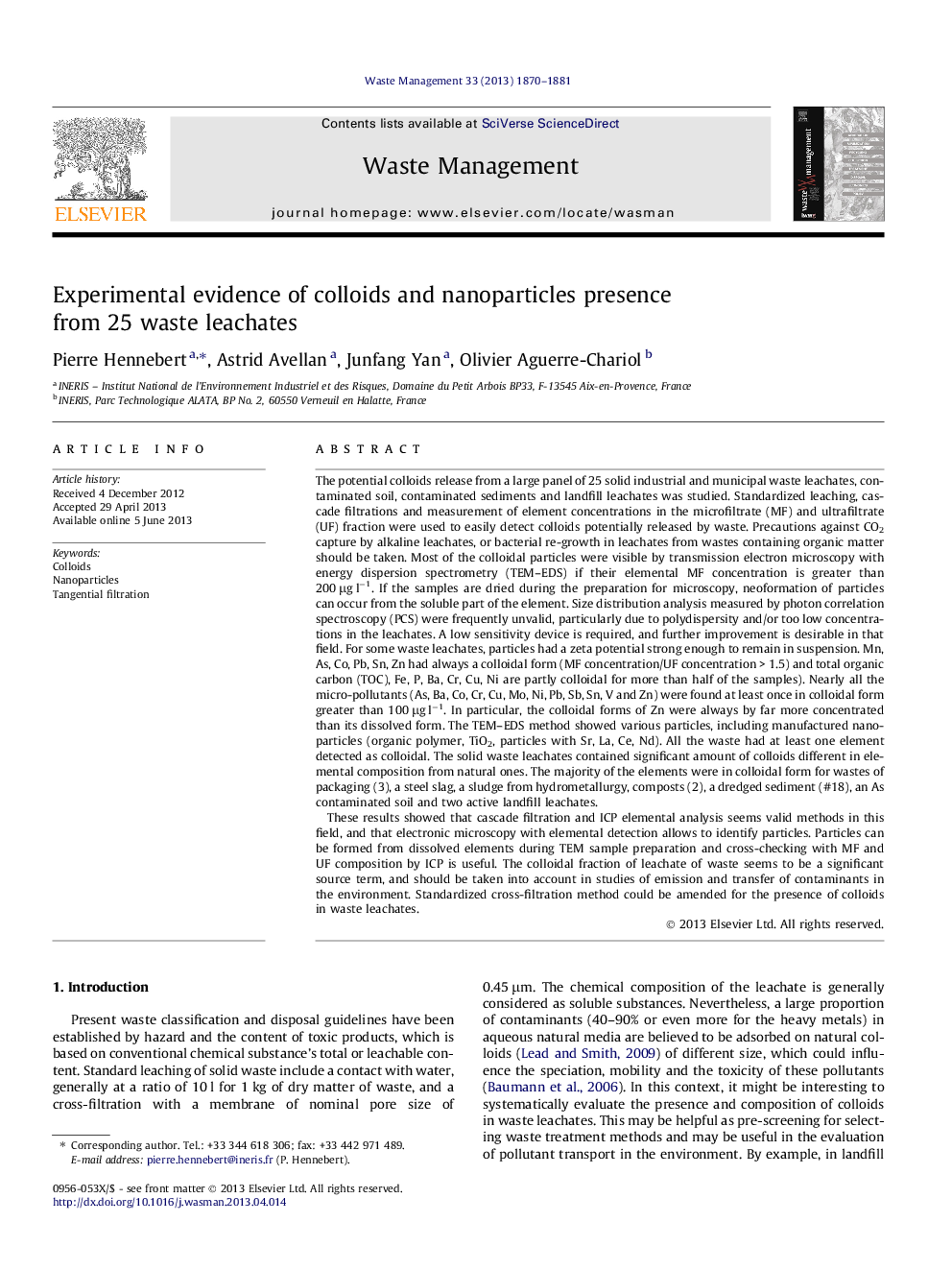| کد مقاله | کد نشریه | سال انتشار | مقاله انگلیسی | نسخه تمام متن |
|---|---|---|---|---|
| 4471835 | 1315045 | 2013 | 12 صفحه PDF | دانلود رایگان |

• This work is the first assessment of colloids in waste leachates.
• Analytical methods are proposed and discussed.
• All the waste have at least one element in colloidal form, and some elements are always colloidal.
• Man-made nanoparticles are observed.
• It can change the interpretation of leachate elemental concentration.
The potential colloids release from a large panel of 25 solid industrial and municipal waste leachates, contaminated soil, contaminated sediments and landfill leachates was studied. Standardized leaching, cascade filtrations and measurement of element concentrations in the microfiltrate (MF) and ultrafiltrate (UF) fraction were used to easily detect colloids potentially released by waste. Precautions against CO2 capture by alkaline leachates, or bacterial re-growth in leachates from wastes containing organic matter should be taken. Most of the colloidal particles were visible by transmission electron microscopy with energy dispersion spectrometry (TEM–EDS) if their elemental MF concentration is greater than 200 μg l−1. If the samples are dried during the preparation for microscopy, neoformation of particles can occur from the soluble part of the element. Size distribution analysis measured by photon correlation spectroscopy (PCS) were frequently unvalid, particularly due to polydispersity and/or too low concentrations in the leachates. A low sensitivity device is required, and further improvement is desirable in that field. For some waste leachates, particles had a zeta potential strong enough to remain in suspension. Mn, As, Co, Pb, Sn, Zn had always a colloidal form (MF concentration/UF concentration > 1.5) and total organic carbon (TOC), Fe, P, Ba, Cr, Cu, Ni are partly colloidal for more than half of the samples). Nearly all the micro-pollutants (As, Ba, Co, Cr, Cu, Mo, Ni, Pb, Sb, Sn, V and Zn) were found at least once in colloidal form greater than 100 μg l−1. In particular, the colloidal forms of Zn were always by far more concentrated than its dissolved form. The TEM–EDS method showed various particles, including manufactured nanoparticles (organic polymer, TiO2, particles with Sr, La, Ce, Nd). All the waste had at least one element detected as colloidal. The solid waste leachates contained significant amount of colloids different in elemental composition from natural ones. The majority of the elements were in colloidal form for wastes of packaging (3), a steel slag, a sludge from hydrometallurgy, composts (2), a dredged sediment (#18), an As contaminated soil and two active landfill leachates.These results showed that cascade filtration and ICP elemental analysis seems valid methods in this field, and that electronic microscopy with elemental detection allows to identify particles. Particles can be formed from dissolved elements during TEM sample preparation and cross-checking with MF and UF composition by ICP is useful. The colloidal fraction of leachate of waste seems to be a significant source term, and should be taken into account in studies of emission and transfer of contaminants in the environment. Standardized cross-filtration method could be amended for the presence of colloids in waste leachates.
Journal: Waste Management - Volume 33, Issue 9, September 2013, Pages 1870–1881